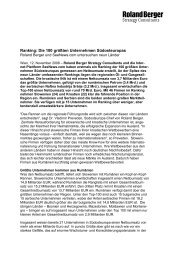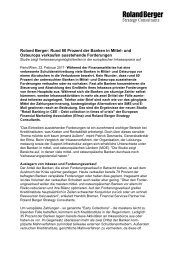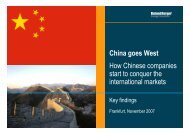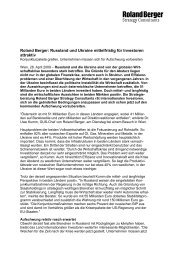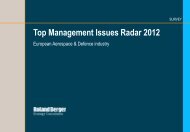global topiCS 8 billion - Roland Berger
global topiCS 8 billion - Roland Berger
global topiCS 8 billion - Roland Berger
You also want an ePaper? Increase the reach of your titles
YUMPU automatically turns print PDFs into web optimized ePapers that Google loves.
<strong>Roland</strong> <strong>Berger</strong> Strategy Consultants<br />
Study<br />
In-depth knowledge for decision makers<br />
2007 2012<br />
USD 20 bn<br />
India<br />
China<br />
USD 100 bn<br />
x2<br />
China and India doubled their R&D spending<br />
between 2007 and 2012 up to USD 200 <strong>billion</strong><br />
(China) and USD 40 <strong>billion</strong> (India). These<br />
two countries now account for almost 20% of<br />
<strong>global</strong> R&D spending.<br />
Emerging markets are changing the <strong>global</strong> innovation agenda<br />
<strong>global</strong> topics<br />
8 <strong>billion</strong><br />
Competition is heating up in emerging markets as more and more<br />
local companies innovate rather than rely on low costs to attract<br />
customers. Not only are emerging countries investing a higher<br />
proportion of <strong>global</strong> R&D spend, but emerging market competitors<br />
apply innovative techniques to manufacture a new class of frugal<br />
products that could transform markets across the world.
The market potential for an innovative and affordable car like the<br />
Tata Nano is enormous in developing and emerging countries
Study 3<br />
<strong>global</strong> topics<br />
8 <strong>billion</strong><br />
Emerging markets are changing the <strong>global</strong> innovation agenda<br />
contents<br />
introduction<br />
Why emerging country innovation quickens competition through R&D hubs and frugal products<br />
The rise of emerging market<br />
innovation hubs<br />
Where to find the inventors of tomorrow<br />
Rethinking innovation strategies<br />
for emerging market success<br />
What are the strategic success factors<br />
Conclusion<br />
How to benefit from this change in <strong>global</strong> innovation management<br />
p 4<br />
p 6<br />
p 16<br />
p 34
<strong>Roland</strong> <strong>Berger</strong> Strategy Consultants<br />
introduction<br />
Why emerging country innovation quickens competition<br />
through R&D hubs and frugal products
Study 5<br />
European managers see exciting prospects in emerging markets.<br />
Higher growth rates, rising young populations, an expanding<br />
middle class, major infrastructure projects and changing trade<br />
patterns are just some of the factors that promise substantial<br />
new business opportunities. But emerging country companies<br />
also spot these opportunities. And they are drawing upon<br />
strengthening R&D capabilities to innovate and deliver competitive<br />
products across every sector.<br />
China is the world's most prominent emerging R&D hub, lifting its<br />
share of <strong>global</strong> R&D expenditures between 2007 and 2012 to<br />
reach about 14% of total worldwide R&D spending. Over the same<br />
period, shares of developed R&D investments dipped<br />
significantly 1 .<br />
China and India have also become net exporters of R&D services to<br />
the EU as their growing R&D competence and status attract more<br />
R&D projects. Between 2005 and 2010, the value of EU 27 imports<br />
of Chinese R&D services quadrupled from EUR 211 million to<br />
EUR 953 million, while imports from India increased from EUR 507<br />
million to EUR 734 million. A previous EU 27 external R&D services<br />
trade surplus is now a deficit of EUR 659 million for India and<br />
EUR 454 million for China 2 .<br />
More and more emerging country manufacturers deliver products<br />
with a speed, well-targeted design and affordable price that make<br />
for daunting competition. In reaching for a competitive response,<br />
European manufacturers may find that their innovation management<br />
and product development expertise and experience can<br />
ironically be a hindrance. Why?<br />
A slightly waggish answer is that advanced economies enable<br />
more people to buy products by comparing features rather<br />
than functions. Design elements, performance options and nonessential<br />
items are features manufacturers introduce to<br />
differentiate and justify higher prices. Many manufacturers have<br />
become quite adept at juggling these non-essential features to<br />
increase margins or encourage customers to buy a newer model.<br />
But emerging market customers cannot afford these features.<br />
Manufacturers must compete on the value and performance<br />
of core product functions. Cost/value competition is much more<br />
demanding when the customer only rates the performance of a<br />
small set of functions. The competitive vocabulary is very different<br />
in emerging markets.<br />
Today, many European manufacturers recognize that stripping<br />
down advanced economy products originally engineered to<br />
promote features will not make a competitive platform in emerging<br />
markets. The price often cannot match local competitor prices.<br />
And increasingly local competitors offer better performance and<br />
value across a few functions. The challenge for European<br />
companies is how to apply their manufacturing, technical<br />
and marketing expertise to support products engineered and<br />
manufactured in the emerging markets. Because if they cannot<br />
transfer and translate significant relevant corporate knowledge<br />
and experience to help local R&D and manufacturing, European<br />
companies lose a potential "value add" advantage competing<br />
with local manufacturers.<br />
The changing <strong>global</strong> R&D landscape with the emerging country<br />
innovation hubs and local engineering inaugurates a new class of<br />
competitive products designed, engineered and priced for the<br />
low to mid-range market segments. These inventions are called<br />
frugal products. In many industries and sectors, they are the<br />
world's fastest growing segments. For example, strong demand in<br />
emerging and developed countries boosts sales of medium and<br />
low-end mechanical engineering technologies above world market<br />
averages. According to <strong>Roland</strong> <strong>Berger</strong> estimates, <strong>global</strong> CAGR<br />
2010-2015e for high-end technologies is a respectable 6%. But<br />
low-end and mid-range technologies will likely enjoy very<br />
robust growth at 11% and 10% CAGR.<br />
Frugal products pitched to low- and mid-range consumers are<br />
growing profit centers in emerging markets. And the welcome<br />
surprise is that good quality, limited function machines and<br />
products can often in turn create profitable new market niches in<br />
advanced economies – very often without cannibalizing sales of<br />
higher priced, more feature-laden products. This "reverse"<br />
or "transnational" innovation shift introduces a new era in world<br />
economic development.<br />
This chapter will look at how emerging country R&D hubs and<br />
frugal product manufacturing are changing competition in the<br />
Focus 20 3 – and forging new business opportunities across<br />
both advanced and emerging markets. We will:<br />
Review the changing <strong>global</strong> innovation environment and rise of<br />
emerging country innovation and R&D, noting representative<br />
developments in selected Focus 20 countries.<br />
Rethink innovation strategy for emerging market success and<br />
identify the basic principles guiding frugal product innovation.<br />
1) Batelle (2012) 2) Eurostat (2012) 3) Chapter 1 introduced 20 emerging<br />
markets projected to have the most economic growth up to 2030: Argentina, Brazil,<br />
China, Colombia, Egypt, India, Indonesia, Iran, Iraq, Malaysia, Mexico, Nigeria,<br />
Pakistan, Peru, Russia, Saudi Arabia, South Africa, Thailand, Turkey and Vietnam.
<strong>Roland</strong> <strong>Berger</strong> Strategy Consultants<br />
The rise of emerging market<br />
innovation hubs<br />
Where to find the inventors of tomorrow
Study 7<br />
f1<br />
Global R&D spending is projected to rise in 2012 by about 5.2%<br />
to reach more than USD 1.4 trillion, slightly below the 6.5%<br />
increase in 2011 after the <strong>global</strong> recession and government<br />
R&D incentives.<br />
The <strong>global</strong> R&D landscape is changing. Emerging markets are<br />
advancing from production sites and work benches to become<br />
important innovation hubs: Many emerging countries have<br />
not only increased R&D investments but also moved up the<br />
<strong>global</strong> innovator leagues tables.<br />
Most notably, over the last few years China and India substantially<br />
boosted their share of <strong>global</strong> R&D spending. Between 2007 and<br />
2012 they doubled their spending from USD 100 to 200 <strong>billion</strong><br />
(China) and USD 21 to 40 <strong>billion</strong> (India). These two countries now<br />
account for almost 20% of <strong>global</strong> R&D spending.<br />
Focus 20 country developmental priorities currently limit total<br />
resources dedicated to research, but R&D spending will rise as<br />
their economies grow. Indeed, some emerging market companies<br />
already allocate considerably higher percentages of revenue to<br />
research than national averages. One result is that five Focus 20<br />
companies from China, India and Brazil now rank among the Top<br />
20 of Forbes 2011 Most Innovative Companies. In 2010, 44 of the<br />
1,000 biggest technology companies (in terms of R&D spending)<br />
were headquartered in emerging markets, more than double<br />
the 16 enterprises cited five years earlier. Chinese and Hong Kong<br />
companies represent most of these high spenders, followed by<br />
Indian and Brazilian companies.<br />
Skilled people are, of course, a precondition to boosting innovative<br />
performance and several emerging markets are enjoying a brain<br />
gain as the number of young skilled workers increases. For ex ample,<br />
between 2004 and 2011 the BRIC student population grew by<br />
more than 7% annually, while large European countries such as<br />
Germany saw student enrollments increase by only 2%. The<br />
availability of researchers and engineers, especially across Asia<br />
and Africa/Arabia, is also improving. Between 2004 and 2007,<br />
Chinese engineering graduates doubled from 1 to 2 million, while<br />
in Iran and Saudi Arabia the number of engineers expanded three<br />
to fivefold. But it should also be noted that across many emerging<br />
countries educational quality remains a concern as educational<br />
institutions invest to improve standards.<br />
intellectual property. According to the World Economic Forum,<br />
China, Saudi Arabia, Malaysia and South Africa very successfully<br />
affirm the intellectual property rights of foreign investors.<br />
Unfortunately countries such as India or Indonesia are still low<br />
performers regarding intellectual property protection.<br />
F1<br />
Emerging markets' shares of world<br />
R&D budget are increasing<br />
Share of <strong>global</strong> R&D spending 4 (USD bn, %)<br />
2.0%<br />
9.5%<br />
13.5%<br />
25.9%<br />
US Europe China<br />
Japan<br />
2007<br />
India<br />
∑ USD 1,058 bn<br />
∑ USD 1,403 bn<br />
2.9% +0.9%-pts.<br />
+4.7%-pts.<br />
14.2%<br />
11.2%<br />
-2.3%-pts.<br />
24.1%<br />
34.3% 31.1%<br />
2012<br />
-1.8%-pts.<br />
-3.2%-pts.<br />
f2<br />
One indicator of a country's evolution toward higher "information<br />
society" economic development are legal protections granted to<br />
Source: Batelle<br />
4) Gross domestic expenditure on R&D
<strong>Roland</strong> <strong>Berger</strong> Strategy Consultants<br />
F2<br />
Availability of scientists or engineers and<br />
intellectual property protection in Focus 20<br />
countries differs significantly<br />
Iran<br />
Turkey<br />
Iraq<br />
Mexico<br />
Egypt<br />
Colombia<br />
Nigeria<br />
Peru<br />
Brazil<br />
South Africa<br />
Argentina
Study 9<br />
Russia<br />
Pakistan<br />
China<br />
Saudi Arabia<br />
India<br />
Thailand<br />
Vietnam<br />
Malaysia<br />
Indonesia<br />
Availability of scientists and engineers<br />
in Focus 20 countries:<br />
High performer<br />
Low performer<br />
Intellectual property protection<br />
in Focus 20 countries:<br />
High performer<br />
Low performer<br />
Note: Country positions relative to average<br />
WEF Global Competitiveness ranking
<strong>Roland</strong> <strong>Berger</strong> Strategy Consultants<br />
Emerging market R&D output is increasing. Between 2000 and<br />
2010, emerging country patent registrations in Europe and the US<br />
grew significantly. Not only do well-known innovators such as<br />
China and India show double-digit patent registration growth rates,<br />
but also such countries as Brazil, South Africa, Russia and<br />
Saudi Arabia.<br />
1,652<br />
F3<br />
High innovation output<br />
Patents registered in Europe and the US by<br />
country of origin (number)<br />
Source: Euromonitor<br />
China<br />
India<br />
Russia<br />
South Africa<br />
Brazil<br />
Saudi Arabia<br />
465<br />
US Patent and<br />
Trademark Office 2010<br />
112<br />
94<br />
68<br />
115<br />
74<br />
87<br />
66<br />
121<br />
31<br />
72<br />
2000<br />
2000 2010 2000 2010 2000 2010 2000 2010 2000 2010<br />
587<br />
200<br />
European<br />
Patent Office<br />
78<br />
57 44<br />
11<br />
7<br />
24<br />
27<br />
13<br />
2<br />
20<br />
2000 2010 2000 2010 2000 2010 2000 2010 2000 2010 2000 2010
Study 11<br />
LOOK BEYOND CHINA AND INDIA<br />
the changing profile of emerging market<br />
R&D hubs<br />
To date, most <strong>global</strong> company R&D hubs are in either India or<br />
China. Eight of the ten <strong>global</strong> companies funding the world's<br />
largest R&D budgets are establishing R&D facilities in these two<br />
countries. Some companies, such as Microsoft, Nestlé, Intel<br />
and Novartis, support both Chinese and Indian hubs. But R&D<br />
internationalization is expanding as multinationals seek greater<br />
local capabilities and market access. They are looking closer<br />
at setting up R&D hubs in other emerging economies. We have<br />
chosen four upcoming R&D hubs from Latin America, Eastern<br />
Europe, Arabia and Asia to demonstrate the changing inter national<br />
R&D environment.<br />
F4<br />
New emerging market R&D<br />
hubs are on the rise<br />
Innovation centers of leading companies<br />
in selected emerging markets<br />
brazil indonesia russia saudi arabia<br />
R&D investments<br />
in USD <strong>billion</strong><br />
19.4 (2011)<br />
1 (2010)<br />
23.1 (2011)<br />
0.7 (2007)<br />
% of GDP<br />
0.9 (2011)<br />
0.1 (2010)<br />
1.1 (2011)<br />
0.3 (2007)<br />
Availability of<br />
scientists<br />
– +<br />
+ +<br />
Intellectual property<br />
protection<br />
– – –<br />
+<br />
University /industry<br />
collaboration<br />
+ + – +<br />
Innovation<br />
industry fields<br />
Renewable energy, IT,<br />
petrochemicals<br />
IT, automobile IT, pharmaceuticals IT, high-tech<br />
Note: Country positions relative to average WEF Global Competitiveness ranking
<strong>Roland</strong> <strong>Berger</strong> Strategy Consultants<br />
brazil<br />
Indonesia<br />
19.4 bn 1bn<br />
R&D investments in 2011, 0.9% of GDP<br />
R&D investments in 2010, 0.1% of GDP<br />
Brazil, the "green giant" rich in natural resources and biodiversity,<br />
has enormous R&D potential to develop for new forms of energy,<br />
agro-technology and biomedicine. Brazilian advances in renewable<br />
energies win worldwide recognition. Notably, Empresa Brasileira<br />
de Aeronáutica (EMBRAER) launched the first aircraft to fly ex clusively<br />
on ethanol. Petróleo Brasileiro (or Petrobras), a semipublic<br />
Brazilian multinational energy corporation, plans to invest USD<br />
4.5 <strong>billion</strong> in R&D over the next five years. The company focuses<br />
on advancing technologies for ultra-deepwater oil production.<br />
Brazil offers labor scalability and R&D skills across many types<br />
of manufacturing, IT and petrochemicals, positioning the country<br />
favorably compared to other Latin American countries that do<br />
not share a similar range of R&D services. To date, automotive<br />
manufacturers are the principal companies building R&D centers.<br />
But IT infrastructure enterprises and R&D engineering are<br />
be ginning to arrive. For example, General Electric will link its latest<br />
USD 100 million Global Research Center in Rio de Janeiro with<br />
other GE research hubs in Niskayuna (USA), Shanghai, Bangalore<br />
and Munich.<br />
Brazil has been continuously improving its patent protection<br />
system, although its current position in the World Economic<br />
Forum's Intellectual Property Protection Index at 3.2 (84 out of<br />
142) remains below average. Recent actions by the Brazilian<br />
Patent and Trademark Office and the National Council of Justice<br />
have reduced the time required for foreign patent applications,<br />
and more generally, diminished intellectual property processing<br />
times for both Brazilian and foreign companies.<br />
Indonesia's current R&D investment doubled research funding five<br />
years ago and the government now identifies R&D as a principal<br />
driver to develop the economy. Indonesia set a long-term goal to<br />
increase R&D investments from under 1% of GDP to 3%. To reach<br />
this objective, the country offers various tax and trade incentives,<br />
as well as technical assistance to businesses, whether private,<br />
state-owned, or cooperatives, that invest some profits<br />
into research.<br />
Prominent international companies, such as Unilever, recently<br />
launched R&D hubs in Indonesia. In 2011 RIM began R&D<br />
activities, the same year Nissan set up an R&D center. Daihatsu<br />
intends to use Indonesia as a base to expand regional activities<br />
and in 2011 the automaker inaugurated an R&D center on the<br />
site of its new manufacturing plant.<br />
Indonesia offers two forms of patent protection: patents (20-year<br />
term) or simple patents (10-year term and lower level of<br />
inventiveness). The patent registration and application processes<br />
have become more streamlined and revised intellectual property<br />
pre-hearing procedures now considerably reduce both time and<br />
expenses. Regarding availability of scientists as well as university/<br />
industry collaboration Indonesia performs above average.
Study 13<br />
Russia<br />
Saudi Arabia<br />
23.1 bn 708 mn<br />
R&D investments in 2011, 1.1% of GDP<br />
R&D investments in 2007, 0.3% of GDP<br />
The Russian government plans to develop a Russian Silicon Valley<br />
near Moscow where Nokia recently inaugurated a handset R&D<br />
facility. Announced in 2012, the plan is to invest USD 3 <strong>billion</strong> over<br />
the next three years to build the Skolkovo Center for Innovation<br />
and Entrepreneurship as the cornerstone for a major high-tech<br />
presence in the mobile market. Intel is one of the most active<br />
major companies investing in Russia and former CEO Craig Barrett<br />
co-chairs the Skolkovo Foundation Council. Other prominent<br />
in dustrial investors include Quintiles and Astra Zeneca. Russian<br />
high-tech R&D support also extends to funding wireless<br />
infrastructure joint ventures between Russian state-owned<br />
manufacturers and such foreign partners as Nokia Siemens<br />
Networks and Huawei. However, a concern restricting large vendor<br />
investments has been a poor intellectual property protection<br />
record. While Russia is expected to strengthen rules to match<br />
international standards, the country's current position in the WEF<br />
Intellectual Property Protection Index at 2.5 (position 126 out of<br />
142) is below average.<br />
The Saudi economy is highly dependent on petroleum and related<br />
products. The government issued development goals to create a<br />
more knowledge-driven economy and 96% of respondents in the<br />
GE Innovation Survey reported that the Saudi innovation en vironment<br />
has improved over the past five years. The King Abdullah<br />
University of Science and Technology (KAUST), inaugurated in<br />
late 2009, seeks to promote university/business collaboration by<br />
attracting world-renowned scientists and top students.<br />
In 2011 Siemens Energy founded an R&D center with the King<br />
Fahd University of Petroleum & Minerals in Dhahran, a leading<br />
Middle East research and teaching institution, to offer R&D<br />
support for energy related issues, as well as university student<br />
and outreach training. In 2010 Intel opened as part of the<br />
company's Digital Transformation Initiative an R&D center to<br />
explore wireless applications in the Kingdom and wider region.<br />
Patent protection in Saudi Arabia lasts 20 years and the time<br />
between application and registration is about three years. The<br />
country has a satisfactory score of 5.1 (position 25 out of 142)<br />
in the WEF Intellectual Property Protection Index.
<strong>Roland</strong> <strong>Berger</strong> Strategy Consultants<br />
F5<br />
Companies that invest more than<br />
60% of their R&D spend in international<br />
research operations showed a 40%<br />
increase in market capitalization<br />
Index: 100 = firms with
Study 15<br />
Emerging market R&D hubs are strategic<br />
local success factors<br />
The United Nations World Investment Report estimates that<br />
approximately 21,500 multinationals do business in emerging<br />
countries. Prominent multinationals such as Microsoft, PepsiCo,<br />
IBM, Cisco, Nokia, GE, and Xerox have also established R&D hubs in<br />
emerging markets to conduct scientific and engineering research,<br />
and explore next-generation business models and organizational<br />
structures. A top motivation is to design economical, sustainable<br />
products and methods for <strong>global</strong> roll-out. These companies want to<br />
create new designs that could potentially reduce costs by orders<br />
of magnitude – a 90% reduction rather than 10% cost savings.<br />
F6<br />
Market and technology access are<br />
clearly more important than cost in<br />
the set-up of corporate R&D<br />
Setting up corporate R&D<br />
5<br />
5 = Very important<br />
f5<br />
For <strong>global</strong> companies, an international platform of R&D hubs is<br />
essential because local R&D capabilities help position products to<br />
local markets and customer requirements. A study by Jaruzelski<br />
and Dehoff (2008) found that technology firms with <strong>global</strong><br />
R&D activities can, on average, demonstrate better financial performance:<br />
higher margins, profits and market capitalization.<br />
Companies that restrict foreign R&D to a few locations and focus<br />
on low-wage countries such as China and India also earn aboveaverage<br />
financial success.<br />
4<br />
3.7<br />
3.4<br />
Main drivers<br />
f6<br />
However, cost is not the principal motivation in selecting an R&D<br />
location. A 2009 <strong>Roland</strong> <strong>Berger</strong> R&D study confirms an intuitive<br />
assessment that access to markets and technological expertise<br />
are the most important criteria when deciding where to base<br />
R&D centers. Cost considerations may heavily influence project<br />
investment decisions, but are generally less relevant when<br />
determining where to set up strategic R&D hubs. Access to<br />
international talent can also be a prime motivator for moving R&D.<br />
3<br />
2.4<br />
Managing extended supply chains is a standard function of<br />
contemporary multinationals. But while some industries and<br />
manufacturers are now looking to reduce supply chain complexity,<br />
many managers recognize that supply chain components<br />
also need to change because competition shrinks time-to-market<br />
across numerous sectors and countries. To bring out better<br />
products faster, R&D functions must align more closely with local<br />
sales and marketing. And in the Focus 20 countries, this means<br />
looking at new ways to manage local innovation.<br />
2<br />
1 1 = Not very important<br />
Source: <strong>Roland</strong> <strong>Berger</strong><br />
Access to<br />
markets<br />
Access to<br />
technological<br />
know-how<br />
Cost reduction
<strong>Roland</strong> <strong>Berger</strong> Strategy Consultants<br />
Rethinking innovation<br />
strategies for emerging<br />
market success<br />
What are the strategic success factors
Study 17<br />
The right mindset for innovations<br />
Favorable regulations and ready access to well-educated local<br />
scientists and engineers are frequently mentioned when considering<br />
locating R&D hubs in emerging countries. However, they<br />
are not the only key success factors. A Western corporation<br />
needs an open mindset to understand a country's culture and<br />
consumer behavior patterns.<br />
Consider Heinz Ketchup, the food company that very early<br />
learned how to match products and distribution methods to local<br />
needs and values. Heinz's emerging country food ventures<br />
apply a rigorous "4A" program to score a new product's applicability,<br />
availability, affordability and affinity in emerging markets.<br />
Managers first consider applicability. Could the product's<br />
ingredients, appearance and taste complement the prospective<br />
country's culture? Availability identifies appropriate sales<br />
channels. Affordability reviews how to deliver the product at an<br />
attractive sales point. Lastly, if these analyses suggest potential,<br />
managers explore branding. Does the product have sufficient<br />
local cultural affinity to develop an effective brand?<br />
This open corporate mindset extends to R&D efforts. Many<br />
emerging country scientists, engineers and researchers have a<br />
different mindset than their Western colleagues. Purchasing<br />
parity statistics can compensate for differences in pay scales. But<br />
they cannot capture differences in outlook, cultural knowledge<br />
and an almost intuitive feel for local sensibilities. Statistics<br />
cannot accurately rate the value of accessing new mindsets to<br />
a corporation. And while the characteristics of this mindset<br />
may be relatively simple to identify – for example, an instinct to<br />
economize rather than elaborate, or an engineering eye for<br />
different patterns – it is sometimes difficult for Western-raised<br />
and -educated researchers to imitate.<br />
This mindset is especially valuable when designing and<br />
manufacturing competitive products for the low to mid market.<br />
Indeed, frugal engineering in more common products is often<br />
faster to market and more financially rewarding than high-profile<br />
R&D efforts to produce world-class patents. As we shall see, not<br />
only are frugal products less expensive to manufacture, but the<br />
strong performance of a few, highly desirable functions can make<br />
them formidable cost-effective competitors.<br />
Frugal products unlock emerging markets<br />
Ten, fifteen years ago, many multinationals could rely on strippeddown<br />
products to earn revenue in emerging markets because<br />
scarcity of competition and novelty made the sale. Today,<br />
understanding emerging country customers' unique cultural<br />
requirements is only the first step. Customers increasingly<br />
choose among several inexpensive, easy-to-use good quality<br />
products. Rising competition over the past decade drives<br />
many local competitors and multinationals to offer better products<br />
and empowers customers to demand products with ever more<br />
buyer favorable price/performance ratios.<br />
Entry-level segment product innovations have expanded to<br />
become a very important growth lever, expanding worldwide at an<br />
annual rate of 7%. The rate is 10% in China and India. This growth<br />
has attracted prominent multinationals. Siemens, for example,<br />
now generates annual entry-level segment sales of USD 10 <strong>billion</strong>,<br />
which represent 14% of total sales.<br />
However, many companies from industrialized countries typically<br />
do not correctly position their products for these high-growth<br />
markets. And by failing to do so, they lose out on potential sales.<br />
For example, German machine tools are recognized worldwide for<br />
their quality, durability, performance and range of features. Along<br />
with automobiles and automotive parts, they are Germany's star<br />
export industries. But as mentioned in the introduction, advanced<br />
economy manufacturers often compete on features rather than<br />
functions. German machine tool manufacturers are no exception.<br />
According to a study by the Fraunhofer Institut für Produktionstechnologie,<br />
German machines are even slightly over-designed<br />
for European customers! Most EU machine tool operators use less<br />
than 80% of a product's features. But the Chinese, who are major<br />
customers, on average use far fewer product features. More<br />
than half of operators report using less than 60% of a machine<br />
tool's features and only 14% access more than 80% of the<br />
machine's feature set.<br />
These heavily over-designed machines will face increasingly<br />
difficult emerging market competition in the fast-growing midrange<br />
segment as local competitors improve the performance<br />
of their more functional machines.
<strong>Roland</strong> <strong>Berger</strong> Strategy Consultants<br />
What are frugal products?<br />
Frugal products, designed for low-end and mid-end market<br />
segments, limit performance to a narrow set of functions.<br />
Successful frugal products are volume-driven, simple, robust /<br />
maintenance-friendly, timely-to-market designs sold at a<br />
comparatively low price. They should be conceived from the<br />
bottom up and integrate selected higher-end components<br />
or features only when absolutely necessary.<br />
Frugal products can be found in many industries.<br />
F7<br />
Frugal products are characterized by<br />
special attributes<br />
attributes<br />
characteristics<br />
Performance<br />
Low-low-end<br />
Low-end Mid-end High-end<br />
Simplicity<br />
Simple<br />
Complex<br />
Robustness<br />
Robust/maintenance-friendly<br />
Fragile/ laborious to maintain<br />
Economies of scale<br />
High volume<br />
Medium volume<br />
Low volume<br />
Pricing<br />
Low price Medium price High price/premium<br />
Source: <strong>Roland</strong> <strong>Berger</strong>
Study 19<br />
1<br />
Tata Nano<br />
Family transportation for Indian mass<br />
market as alternative to two-wheelers<br />
Improvements as compared<br />
to two- wheelers<br />
- Safe<br />
- All-weather<br />
- Affordable<br />
Filling "white spot" between<br />
two-wheelers and mini cars
<strong>Roland</strong> <strong>Berger</strong> Strategy Consultants<br />
2 Chip x-gold 101<br />
Mobile phone chip enabling "ultra<br />
low cost mobile phones" for emerging<br />
markets<br />
Improvement as compared<br />
to conventional chips: single chip<br />
integration<br />
All functions in one silicon piece<br />
Material cost reduction<br />
Reduced phone design effort
Study 21<br />
3<br />
Annapurna salt<br />
Refined iodized salt sold in small,<br />
affordable sachets<br />
Improvement as compared to normal salt:<br />
Iodine is released only when salted food<br />
is ingested
<strong>Roland</strong> <strong>Berger</strong> Strategy Consultants<br />
4 USD 100 laptop<br />
Cheap and robust laptop for educating<br />
children<br />
Especially created for developing<br />
countries as a charity project to<br />
improve education standards but also<br />
for industrialized countries<br />
Target: Create a laptop which is as cheap<br />
as possible, using standard low-end parts<br />
Production of high volumes to ensure<br />
economies of scale
Study 23<br />
5<br />
X-ray apparatus<br />
Siemens entered emerging markets<br />
with cheap X-ray apparatuses<br />
Mass market with significantly higher<br />
volumes (> 1,000 pcs. p.a.) than established<br />
markets (approx. 100 pcs. for midprice<br />
segment)<br />
Customized for local requirements<br />
(heat, humidity, power blackouts)
<strong>Roland</strong> <strong>Berger</strong> Strategy Consultants<br />
6<br />
Maggi noodles<br />
High-nutrient (dietary fiber, proteins)<br />
and low-cost variant of Maggi noodles<br />
2-per-packet product developed for<br />
the rural poor in India and Pakistan
Study 25<br />
7<br />
Danimal yoghurt<br />
Yoghurt enriched with Vitamin A,<br />
iron and zinc<br />
Launched in 2005 in South Africa, Danimal<br />
helps to fight malnutrition and to create jobs<br />
10% of scales are made by Daniladies who<br />
sell door-to-door in the townships, supervised<br />
by Danigrandmas, women with high level of<br />
education<br />
Yoghurt sold for ca. EUR 0.20
<strong>Roland</strong> <strong>Berger</strong> Strategy Consultants<br />
8 Solar radio<br />
Mobile and robust solar radio<br />
Hand crank for charging radio if no<br />
solar power is available (1 min. of<br />
cranking is sufficient for 20 min. of<br />
listening)<br />
Thus, user is independent of electricity<br />
or batteries<br />
AM and FM reception<br />
Radio sold for EUR 12.50-18.50
Study 27<br />
Frugal innovation success factors<br />
Successful frugal product innovation and roll-out requires local<br />
decision-making authority as managers and engineers allocate<br />
local/regional resources. And to allow this authority, the process<br />
will encourage multinational companies to evolve toward a more<br />
decentralized, culturally diverse <strong>global</strong> profile.<br />
Key frugal product success factors are:<br />
Mindset<br />
Frugal product innovation must start in the company's mindset<br />
because innovation can only succeed if foreign R&D sites are as<br />
integrated into the corporation as are home country innovation<br />
centers.<br />
Local resources<br />
To encourage a decentralized, local-market focus, most if not all<br />
the people and resources dedicated to frugal innovation must<br />
be native to the emerging country.<br />
Local decision-making<br />
Local growth teams (LGTs) need decision-making authority to<br />
choose which products to develop and how to manufacture, sell<br />
and offer aftersales service.<br />
Local financial responsibility<br />
LGTs must have profit and loss responsibility, which has often<br />
been a key hurdle for American multinationals.<br />
Access to <strong>global</strong> corporate resources<br />
LGTs should have the right to draw from corporate <strong>global</strong><br />
resources, which is essential for leveraging corporate assets<br />
into emerging markets.
<strong>Roland</strong> <strong>Berger</strong> Strategy Consultants<br />
Developing frugal products step by step –<br />
the <strong>Roland</strong> <strong>Berger</strong> approach<br />
Unlike advanced economy products, which frequently differentiate<br />
across an array of distinctive features, frugal products compete<br />
on very rigorous performance/cost criteria. But frugal product<br />
innovation is more than cost reduction. To deliver superior, costeffective<br />
performance over a limited set of functions, business<br />
models often need to be reconfigured to create entirely<br />
new production processes and supply chains.<br />
Holistic methods are very much in vogue today and for good<br />
reason. Holistic analysis is particularly appropriate for <strong>global</strong><br />
companies looking to enter emerging markets. And developing<br />
frugal products is a case in point. To bring out successful<br />
frugal products, management should review the entire spectrum<br />
of business and manufacturing activities – from the business case<br />
and product design, value chain configuration and manufacturing<br />
process through risk monitoring and marketing. Frugal product<br />
innovations originate in emerging markets and the most nimble<br />
practitioners today work in these countries. Many companies<br />
from developed nations will need new corporate policies to enable<br />
emerging country engineers and managers to design, develop<br />
and manufacture competitive frugal products from the bottom up.<br />
Local personnel will mostly use local or regional resources,<br />
coordinating where and when appropriate with corporate assets,<br />
skills and capabilities.<br />
A very promising and potentially profitable way to leverage<br />
corporate assets is "reverse" or "transnational" innovation, when<br />
a multinational distributes emerging country frugal products<br />
across the home and other <strong>global</strong> markets.<br />
But more on that later. First, let's review the basic steps.<br />
For a German engineered product company we developed a frugal<br />
product concept for the Chinese market. Rising competition due<br />
to customer consolidation and Chinese machine copies was<br />
increasing cost pressures and misaligning products to customer<br />
requirements. A new strategy focusing on the low/medium<br />
segment and adapting sourcing to a novel production concept<br />
reversed declining sales by earning additional revenue of EUR 50<br />
million.<br />
But how did we achieve this impressive business potential? To<br />
help companies assess and execute the many business,<br />
engineering and manufacturing steps that comprise frugal product<br />
design and production – and see how these activities can be<br />
f8 integrated into the larger corporate organization – <strong>Roland</strong> <strong>Berger</strong><br />
designed a comprehensive six-step framework to plan and<br />
manage the entire frugal product development process.<br />
We'll quickly look at each step:<br />
1 Readiness assessment<br />
This initial phase reviews how well the company's current product<br />
line corresponds with the target markets and customer segments,<br />
and identifies other potential products that would better satisfy<br />
customer requirements.<br />
2 Market analysis<br />
In-depth profiles of the target markets/customer segments, buyer<br />
needs and specifications are used to build pricing and revenue<br />
models. This phase defines the frugal products' functions and<br />
competitive advantages, discovered through expert interviews,<br />
cross-functional workshops and extensive market research.<br />
3 Frugal product design<br />
A three-phase process identifies necessary and non-essential<br />
functions to satisfy customer requirements, estimates costs<br />
using different technical and engineering approaches to produce<br />
the components, then uses a cost/performance matrix to derive<br />
design options.
Study 29<br />
F8<br />
<strong>Roland</strong> <strong>Berger</strong>'s frugal<br />
products framework<br />
1 Readiness<br />
Assessment<br />
2 Market<br />
Analysis<br />
3 Product<br />
Design<br />
4 Value Chain<br />
Configuration<br />
5 Roadmap<br />
Roughly define target<br />
markets/customer<br />
segments and<br />
development strategy<br />
Detail target markets/<br />
customer segments<br />
Systematically<br />
develop the concept<br />
for the technical<br />
solution<br />
Systematically<br />
develop the value<br />
chain concept<br />
Summarize concept<br />
and define next steps<br />
What are customer<br />
requirements<br />
(high level)?<br />
What development<br />
alternatives<br />
do we have?<br />
Which alternative is<br />
most suitable (adapt<br />
an existing product vs.<br />
develop from scratch)?<br />
What is the market<br />
volume /expected<br />
growth?<br />
What are customer<br />
requirements<br />
(in detail)?<br />
What is the target<br />
price /price range and<br />
the revenue model?<br />
What are required<br />
product features?<br />
What product<br />
features are NOT<br />
required?<br />
What are the<br />
product costs?<br />
Development: MoB?<br />
Partnerships? etc.<br />
Procurement: MoB?<br />
Share of BCCS? etc.<br />
Production/<br />
logistics:<br />
Footprint? Etc.<br />
Marketing/sales<br />
channels? etc.<br />
Technical concept and<br />
value chain concept<br />
Business case<br />
Risk management<br />
Implementation<br />
planning<br />
and monitoring<br />
1-4 weeks approx. 3 months<br />
6 Change Management<br />
4 Value chain configuration<br />
Because cost is a major competitive factor, it is essential when<br />
designing a value chain to improve the efficiency of development,<br />
procurement, production footprint, logistics, marketing and sales.<br />
Various analytical methods consider make vs. buy decisions,<br />
sourcing and quality control to create a lean logistics model with<br />
fast throughput.<br />
5 Roadmap<br />
The previous design phase findings, analysis and<br />
recommendations are integrated into a comprehensive<br />
implementation plan to cover the business case, risk<br />
management, as well as execution and monitoring roll-out.<br />
6 Change management<br />
As previously discussed in Chapter 2, to compete successfully<br />
in new emerging markets many European companies should<br />
encourage corporate cultural diversity and greater autonomy for<br />
emerging market subsidiaries. Frugal product development<br />
encourages this evolution because low- to mid-end products will<br />
generate the majority of emerging market revenue for most<br />
companies.<br />
Some multinationals will need to consider revising relevant<br />
corporate policies and organizational procedures. Different change<br />
management techniques and programs can be adapted to suit a<br />
company's particular situation.
<strong>Roland</strong> <strong>Berger</strong> Strategy Consultants<br />
F9<br />
Modularization is considered<br />
the most important factor for<br />
a successful product strategy<br />
in emerging markets<br />
Levers for successful product strategy in emerging markets (%)<br />
Low-cost product<br />
8%<br />
Features strategy with<br />
corresponding pricing<br />
8%<br />
Specialization<br />
(niche strategy)<br />
25%<br />
59%<br />
Modularization<br />
Source: <strong>Roland</strong> <strong>Berger</strong>
Study 31<br />
Modular design – an essential principle<br />
of frugal products<br />
f9<br />
A <strong>Roland</strong> <strong>Berger</strong> study in March 2012 surveyed more than 50<br />
companies from various industries and of all sizes – 57% rank<br />
among the top three in their business – to inquire how they use<br />
modular designs. Modularization takes different forms depending<br />
on the industry and product, but the basic concept is to find an<br />
acceptable compromise between common standardization and<br />
individual customization.<br />
Modularization is a hot topic. Most companies have been pursuing<br />
modularization for more than three years and 60% more than<br />
five years. Two-thirds of all companies surveyed plan to extend the<br />
share of products based on platforms or modules to reach 67% of<br />
revenue share in 2015.<br />
Modularization principles and techniques originated in<br />
manufacturing to see how product platforms and modules could<br />
better serve customers. Companies now look to apply these<br />
concepts across other functions, such as sales, service and<br />
marketing.<br />
modularization strategies lifted emerging market revenue share<br />
by 25% in the decade after 2000, considerably higher than the<br />
survey group's average 18% increase.<br />
Most multinational enterprises and also smaller companies plan<br />
to significantly increase their emerging market R&D activities. By<br />
2020, more than two-thirds of study respondents intend to<br />
engineer more than 20% of their products in emerging markets.<br />
This figure will increase, as ultimately around half of the world's<br />
companies expect to produce more than 40% of their products<br />
in these countries.<br />
Emerging market customers rate performance/value and quality<br />
as particularly important for their purchasing decisions. So it is no<br />
surprise that the overwhelming majority of surveyed companies<br />
see modularization as their most important lever in planning a<br />
successful emerging market product strategy. The default historical<br />
strategy of lowest-cost pricing is no longer relevant in today's<br />
emerging markets.<br />
Study respondents cite three top reasons to expand<br />
modularization:<br />
Reduce product cost<br />
Improve time to market/speed<br />
Reduce complexity<br />
Surprisingly, despite the importance of accurately understanding<br />
customer needs when building platforms and modules, less<br />
than a third of surveyed companies follow a structured approach<br />
to collect and use information about customer requirements.<br />
Strong growth prospects raise the profile of emerging countries<br />
in the surveyed companies' business plans. Today, emerging<br />
markets account for close to a third of the surveyed companies'<br />
revenue and they are expected to generate almost half of total<br />
revenue by 2020. In 2010, the surveyed companies' emerging<br />
market EBIT share was an average 19%, projected to climb to 38%<br />
in 2020. Companies that apply a modularization strategy win<br />
more sales in emerging markets. They can adapt faster to<br />
local customer requirements and reduce costs, often by rapidly<br />
adapting existing modular components. Companies using
<strong>Roland</strong> <strong>Berger</strong> Strategy Consultants<br />
Transnational or<br />
reverse innovation<br />
f10<br />
Frugal products for advanced market niches are a new business<br />
trend. These transnational or reverse innovations are typically<br />
successful frugal products created in an emerging country, that<br />
then become excellent candidates for <strong>global</strong> distribution. Often<br />
these products are manufactured through modular assembly<br />
techniques or pioneer radically new applications.<br />
For example, the car industry is an enthusiastic advocate of<br />
modular techniques to produce automobiles with different prices<br />
and design features. The Indian Tata Nano car is constructed from<br />
modular components that can be built and shipped separately<br />
for assembly at different locations. In effect, the Nano is designed<br />
for distribution in kits that are then assembled and serviced<br />
by local entrepreneurs – whether in other emerging countries or,<br />
as planned, in Europe.<br />
Some prominent emerging market competitors also sell<br />
frugal product innovations beyond their national borders. For<br />
instance Qoros, a Chinese car manufacturer, expanded across<br />
other emerging countries and in 2013 plans to enter the<br />
European market. BYD is the world's largest manufacturer of<br />
re charge able batteries. Huawei, the <strong>global</strong> Chinese telecoms and<br />
consumer electronics giant, serves a growing base of European<br />
clients. Likewise SMEW India, the winding machine manufacturer,<br />
produces successfully for the Italian and Spanish markets.<br />
Here are some other examples showing the diversity of frugal<br />
products competing in advanced economies:<br />
Siemens introduced inexpensive X-ray products and turbines<br />
to attract new emerging market customers – and then marketed<br />
these cheaper products across more advanced markets. Indian<br />
engineers working almost independently designed an X-ray<br />
machine that uses little Siemens proprietary technology and<br />
costs 40% less than other feature-laden Siemens X-ray<br />
equipment. The company has already launched eight products<br />
originating in India, such as a new steam turbine, a fetal<br />
heartbeat monitor and a low-end rail signaling system – soon to<br />
be directing Malaysian trains. And with healthcare costs rising<br />
universally, small hospitals in advanced economies are<br />
discovering the price/performance advantages of "Made in India".<br />
For Siemens, these relatively inexpensive Indian products are<br />
the vanguard of more than 50 in development.<br />
Microsoft's research laboratory in Beijing produced clever<br />
programs for computers to recognize handwriting or transform<br />
photographs into cartoons.<br />
Logitech developed an affordable mouse for the Chinese<br />
market that sells for the Chinese equivalent of USD 19.99 and<br />
is now also available in Europe and the United States.<br />
U.S. Deere & Company designed and manufactured in India<br />
a small tractor, the 35-horsepower Krish, priced to compete with<br />
the market leader, Mahindra & Mahindra. Krish design elements<br />
now appear in Deere products distributed worldwide.<br />
GE Healthcare successfully produced a low-cost<br />
electrocardiogram for the Chinese market and then marketed<br />
the machine in the US without compromising significant<br />
revenues earned by their more expensive electrocardiogram line.<br />
The microfinance institution Grameen Bank established a<br />
branch in the US – Grameen America – to serve the poor.<br />
Coca-Cola launched Pulpy Orange Juice, the first Chinese brand<br />
that the company introduced in the United States.
Study 33<br />
F10<br />
Emerging market companies are<br />
arriving in industrialized markets<br />
Conquering Western<br />
markets<br />
Delta<br />
CG<br />
huawei<br />
tata<br />
byd<br />
zte<br />
Expanding into<br />
emerging markets<br />
qoros<br />
Becoming national<br />
champions<br />
smew<br />
avhan technologies<br />
Starting up in domestic<br />
markets markets<br />
Imitation Basic development Innovation<br />
Source: <strong>Roland</strong> <strong>Berger</strong>
<strong>Roland</strong> <strong>Berger</strong> Strategy Consultants<br />
Conclusion<br />
HOW TO BENEFIT FROM THIS CHANGE IN<br />
GLOBAL INNOVATION MANAGEMENT
Study 35<br />
Until very recently, innovation was almost exclusively an<br />
advanced economy competitive advantage. No longer. Emerging<br />
countries and prominent companies are raising public and private<br />
R&D budgets to fund innovation. And emerging markets' share of<br />
<strong>global</strong> R&D spend is set to climb significantly over the next couple<br />
of decades.<br />
Important R&D hubs are now appearing on every continent<br />
as manufacturers seek to create products catering to cultural<br />
diversity. Emerging market customers are much more<br />
sophisticated and demanding. The lowest-cost, stripped-down<br />
products and a "one-size-fits-all" mentality are strategies<br />
of the past. Today, reliable performance across a narrow set of<br />
functions, moderate price and excellent value make frugal<br />
products the most visible sign of emerging market innovation.<br />
Many multinationals from developed nations are in the midst of an<br />
organizational transition to support much more localized product<br />
design, engineering and manufacturing. This transformation is<br />
an essential step toward manufacturing frugal products that can<br />
attract the low- to mid-end customers who will account for<br />
most emerging market sales in the coming decades. And through<br />
re verse innovation some of these products will win new cus tom ers<br />
in advanced economies.<br />
Emerging markets are looking to encourage innovation through<br />
legal, regulatory and economic assistance. The pace will vary from<br />
country to country, but emerging country R&D hubs are already<br />
part of the next wave of <strong>global</strong>ization. Whether through independent<br />
initiatives or by joining research ventures, European<br />
manufacturers should make frugal products and emerging market<br />
innovation part of their <strong>global</strong> strategy.
<strong>Roland</strong> <strong>Berger</strong> Strategy Consultants<br />
Authors of the study<br />
Dr. Wilfried Aulbur<br />
Partner, Mumbai Office<br />
wilfried.aulbur@rolandberger.com<br />
Per I. Nilsson<br />
Partner, Office Stockholm<br />
per-i.nilsson@rolandberger.com<br />
Bernd Brunke<br />
Partner and Member of the<br />
Executive Committee<br />
bernd.brunke@rolandberger.com<br />
Benno van Dongen<br />
Partner, Amsterdam Office<br />
benno.dongen@rolandberger.com<br />
William Downey<br />
Partner, New York Office<br />
william.downey@rolandberger.com<br />
Dr. Michael Zollenkop<br />
Principal, Stuttgart Office<br />
michael.zollenkop@rolandberger.com<br />
special thanks to<br />
Dr. Verena Reichl and Geoffrey Samuels<br />
credits<br />
Page 2, 20, 21, 25: Corbis<br />
Page 19: Serge Attal/Visum<br />
Page 21: Corbis<br />
Page 22: Jörg Boethling/agenda<br />
Page 23+26: Panos Pictures<br />
Page 24: picture-alliance/abaca
Study 37<br />
Sources<br />
Scott D. Anthony (2006)<br />
Seven Principles of Disruptive Innovation<br />
Battelle (2012)<br />
Global R&D Funding Forecast (2012)<br />
K. Below et al. (2012)<br />
The rise of the BIC countries as knowledge powers?<br />
DB Research (2011)<br />
Research follows production<br />
Euromonitor International (2012)<br />
Consumer data<br />
Eurostat (2012)<br />
Innovation and research data<br />
Experientia (2012)<br />
Designing for emerging markets<br />
J. Gleisberg, O. Knapp, S. Pötzl, M. Becker (<strong>Roland</strong> <strong>Berger</strong>, 2012)<br />
Modular products – How to leverage modular product kits<br />
for growth and <strong>global</strong>ization<br />
B. Jaruzelski, Kevin Dehoff (2008)<br />
Innovation study<br />
O. Knapp, M. Zollenkop, S. Durst (<strong>Roland</strong> <strong>Berger</strong>, 2012)<br />
Frugal products<br />
GLOBAL TOPICS<br />
Project Description<br />
V. Govindarajan (2012)<br />
The $2,000 Car<br />
General Electric (2012)<br />
Global Innovation Barometer<br />
J.R. Immelt (2008)<br />
How GE is disrupting itself<br />
INSEAD (2011)<br />
The Global Innovation Index 2011<br />
Innovation Institute (2012)<br />
The Missing Link between Innovation Strategy<br />
and Leadership in the Middle East<br />
National Science Board (2012)<br />
Science and Engineering Indicators 2012<br />
C.K. Prahalad (2006)<br />
The Innovation Paradox<br />
P. Reddy (2008)<br />
Global Innovation in Emerging Economies –<br />
Implications for Other Developing Countries<br />
World Economic Forum (2012)<br />
WEF Global Competitiveness Report 2011/2012<br />
Michael Zollenkop (<strong>Roland</strong> <strong>Berger</strong>, 2011)<br />
Organizing and managing R&D in<br />
high-tech industries<br />
8 <strong>billion</strong><br />
Upcoming publications<br />
2012 is a year of dramatic economic and social challenges, but<br />
especially of political change, with transitions of power potentially<br />
taking place in 60 countries, affecting 50% of the world's GDP. With<br />
our GLOBAL TOPICS initiative, we assess the most pressing issues<br />
and outline possible solutions for leaders. Leveraging the <strong>global</strong><br />
footprint of our firm, we focus on how debt, welfare issues, energy<br />
supply and demographic change will affect our world. We also<br />
explore how Africa as an entire continent is turning these<br />
challenges into opportunities.<br />
This publication is part four of our series on "Eight Billion<br />
Business Opportunities". The fifth and final installment in the<br />
series for 2012 will be published in winter 2012. It will highlight<br />
prominent trends on how to influence what consumers buy.<br />
But our journey will continue in 2013 with other exciting topics,<br />
such as supply chain management and innovative business<br />
models.
<strong>Roland</strong> <strong>Berger</strong> Strategy Consultants<br />
For more information, please visit:<br />
www.rolandberger.com/<strong>global</strong>topics<br />
If you have any questions, please contact us at:<br />
<strong>global</strong>_topics@rolandberger.com<br />
<strong>Roland</strong> <strong>Berger</strong> Strategy Consultants GmbH<br />
HighLight Towers, Mies-van-der-Rohe-Str. 6, 80807 Munich, Germany<br />
september 2012
Study 39



